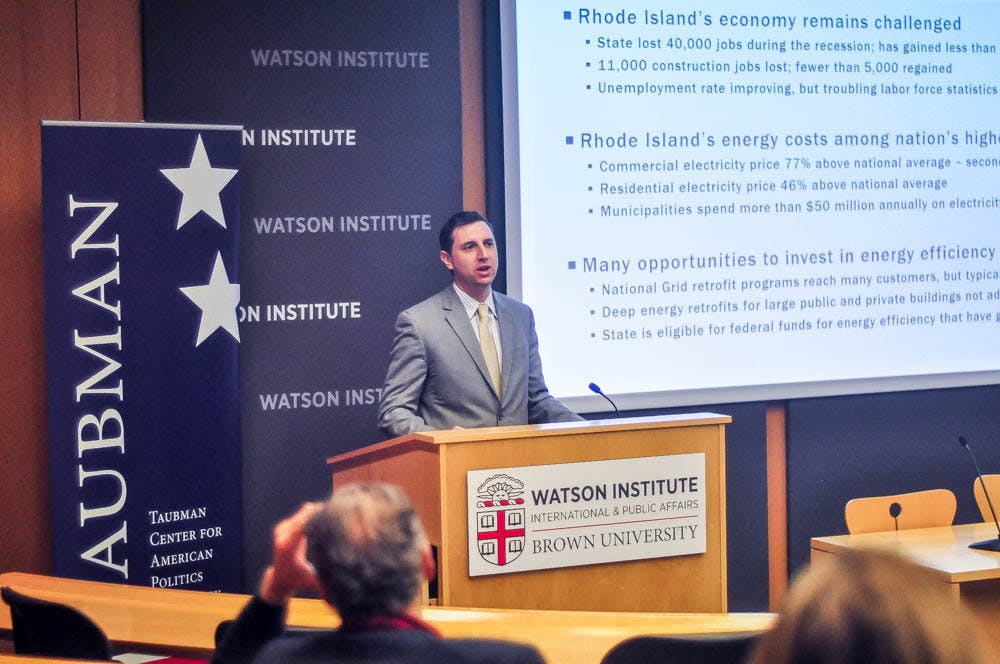Rhode Island General Treasurer Seth Magaziner ’06 gave a lecture titled “Promoting a Clean Economy: The Policy and Legislative Process Behind the Rhode Island Infrastructure Bank” in the Joukowsky Forum on Wednesday.
The event focused on the Rhode Island Infrastructure Bank’s capabilities to create jobs, lower the cost of energy and further sustainability without any impact on the state budget. Roughly 40 students, faculty and staff members attended the event, organized by the Taubman Center for Public Policy and American Institutions.
The Infrastructure Bank consists of two programs: the Efficient Building Fund, which can allocate $20 million in low-cost loans to Rhode Island cities and towns, and the Property Assessed Clean Energy program, which can offer between $4 million and $8 million in loans to residential and commercial property owners, Magaziner said.
Both programs are intended to fund projects that promote efficiency, sustainability and the use of renewable energy. Examples include “everything from wind turbines in West Warwick to rooftop solar panels on schools in Pawtucket,” Magaziner added.
The EBF alone is projected to add 300 to 400 new construction jobs in Rhode Island in its first year and to cut energy costs, especially on older buildings such as schools, libraries and fire stations, Magaziner said.
“The great thing is: Who could be against this? You’ve got jobs, you’ve got lower costs of energy for businesses and homeowners and you’ve got the environmental impacts,” he added. The foundation of the Infrastructure Bank is particularly advantageous to Rhode Island, which still has not regained the 40,000 jobs lost during the recent recession and has a commercial electricity price that is the second highest in the United States.
Magaziner and his team in the treasurer’s office relied largely on private sources of funding for the Infrastructure Bank in order to avoid impacting the state budget.
“PACE is a model that relies almost entirely on private capital. … The way it works is banks or other lenders make the loans. They take the risk,” Magaziner said. Much of the funding for the EBF is funding from the 2009 federal stimulus package earmarked for sustainability efforts in Rhode Island, he added.
After the lecture, Magaziner told The Herald he tried to emphasize the role of private investments in state infrastructure.
“It is important to spread the message that a lot can be accomplished by finding innovative ways to finance infrastructure projects,” he said.
The concept of the Infrastructure Bank was drawn both from an existing Rhode Island program and the examples of other states. The EBF was built on the foundation of the Clean Water Finance Agency, which fulfilled a similar function, Magaziner said. The PACE program is based on a similar program already operating effectively in Connecticut, he added.
“I really like that the bank looked to neighboring states for examples of successful policies,” said Jun Shepard, a research analyst in the economics department. “It also verifies a lot of research that has been done on how these policies are made.”
Shepard, who attended the event because her research centers on environmental policies in Rhode Island, added that the examples of other states also suggest that the Rhode Island Infrastructure Bank should be effective.
“State-level policies are really important because they better provide a stimulus to expand renewable energy production, and other states with green banks have been successful,” she said.
Other attendees expressed similar approval of the concept and mission of the Infrastructure Bank during the question-and-answer portion of the lecture.
“I’m particularly interested in this because I come from India and I think this is what is needed in different parts of the globe,” one audience member said.
Another expressed concern about opportunities for minority citizens and communities both in the allocation of funds and the hiring of contractors. Magaziner said that all of the state’s majority-minority communities applied for loans from the Infrastructure Bank and are likely to receive them.
“For PACE, when we’re training contractors and letting them know how it works,” the treasurer’s office will make sure to work with associations of black and Latinx contractors, he added.
The first loans from both the EBF and PACE will be issued this summer. Magaziner and his team must now grapple with concerns including finding sources of future funding for the EBF, which — unlike PACE — is not sustainable over time, and expanding the focus of the Infrastructure Bank to include climate change adaptation, Magaziner said.
“As the Ocean State, as a low-lying, coastal series of communities that is particularly prone to flooding and extreme weather events,” Rhode Island should make subsidizing projects like the construction of sand dunes, seawalls and other defenses a priority, he added.





